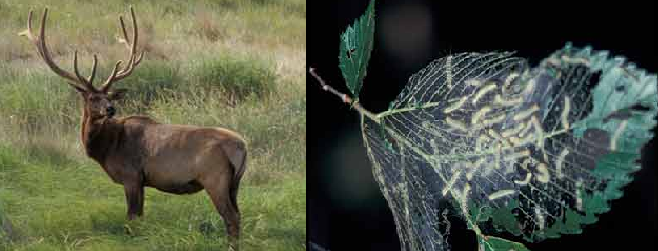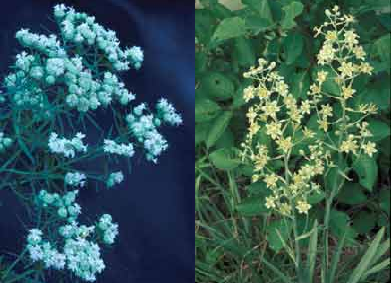Herbivores vs. Plants: The Silent Battle
Posted on June 20, 2016 in Blog

What do a huge elk and these tiny insect larvae have in common? Both are herbivores, or plant eaters. From the plants’ point of view, herbivores are “terrorists” that demand an array creative defenses. Try to spot some on your next nature outing!
Text and photos by Dr. Thomas Rosburg
If you spend time outdoors in nature, you will surely witness one of the most common ways that species interact. It may be quite dramatic, such as a Cooper’s hawk darting through a dim forest to snatch a sparrow. Or it may be much more subtle and serene, perhaps a rabbit nibbling on some clover. In either case, one species is consuming another. This interaction, called consumerism, always results in a positive outcome for one species and a negative effect for the other.
Biologists identify the consumption of animals as carnivory, while herbivory is the consumption of plants or fungi. Many people probably think carnivory is impressively gruesome, while herbivory is boring and unexciting. A closer look at plants might change their minds!
Herbivory 101
Herbivory can either kill or simply weaken the plant victim. While the latter is more common, it, too can become deadly—as when grazing occurs on small seedlings or amidst other stresses like competition, drought or fire.
Many animals practice herbivory—from browsing elephants to tiny insect leaf miners. It’s also practiced by fungi, bacteria and even other plants. For example, Dutch elm disease is caused by a fungus (Ophiostoma species) and many herbaceous plant species are afflicted with fungal rusts (Puccinia species). Bacteria such as Pseudomonas and Xanthomonas cause plant diseases such as blight, wilt or spot.
Some herbivorous plants that consume their “brethren” do so because they lack chlorophyll and are incapable of photosynthesis. Dodder (in the genus Cuscuta) has yellow or orange stems that wrap and twist around its host plant. Specialized roots called haustoria penetrate the stems of the host plant and extract sugars. Other photosynthetic plants use herbivory as supplemental nourishment. Bastard toadflax and lousewort occur on Iowa’s prairies and open woodlands. They have haustoria that originate from roots and tap into the roots of neighboring plants, particularly grasses.
Happy Victims?
Herbivory is not always consumerism (very few things in nature are ever without exception). Frugivory (the consumption of fruits) provides a mutual benefit to both species (nourishment for the herbivore and seed dispersal for the plant). Such an interaction is called mutualism.
There is also some evidence (albeit controversial) that grazing and browsing may actually help the plant by stimulating extra growth. For example, when herbivory removes the terminal bud, lateral buds may become more active—resulting in a bushier plant with more flowers (similar to human pruning). Some research with ungulate grazers suggests that both their urine (nitrogen-enriched) and saliva (containing essential vitamins) supports higher plant growth. However, opponents to this theory note that even if herbivory seems to increase above-ground growth, the plant’s underground structures may have been depleted more, thus lowering its total biomass.
Plant Defenses
It may seem that plants—being unable to move around—must take whatever herbivores dish out to them, but that’s not the way it works. Because plants are typically damaged by herbivory, natural selection has helped them develop impressive herbivore defense strategies.
Physical Barriers
Plant hairs, especially when dense as on leadplant leaves, can impede insects and prevent access to leaf surfaces. Sharp-pointed hairs may even impale insects. Glands associated with the hairs may secrete sticky fluids that hinder insect mobility (New England aster) or toxic compounds that irritate and repel insects (stinging nettle). Through natural selection, hairs may be modified into prickles, leaves into spines, or branches into thorns—all very discouraging for grazers and browsers.
Plants use specialized cells, called sclerenchyma, to make tough, herbivore-resistant tissues. Sclerenchyma is put into leaves, seed coats, and fruits (most notably the shells of nuts) to protect the seeds. Grasses and horsetails accumulate silica in epidermal cells to make tissues unpalatable and tough. (Who wants to chew on bits of glass or sand?) Extra thick bark can also provide physical defense.
.png)
The spines on the pads of the fragile prickly pear (left) and the prickles on the stems of the climbing rose (right) help convince herbivores to look elsewhere.
Chemical Weapons
Plants’ chemical arsenals are even more inventive:
- Chemical mimicry: A plant attacked by an insect larvae produces a chemical that mimics an insect pheromone, which are chemicals that insects produce at various stages of their life cycles to communicate and to mediate development. In this case, the plant’s fake pheromone tricks the insect into advancing into the next stage of its life cycle, perhaps diapause (a resting state) or metamorphosis. Either way, the insect stops eating when it advances out of the larval stage.
- Decreased food quality: Oak, maple and acacia leaves make and accumulate tannin over the growing season. Tannins interfere with the herbivore’s digestive enzymes, reducing the plant’s food value.
- Toxins: These chemicals disrupt important physiological processes. For example, scientists have discovered over 10,000 types of alkaloids in plants. They include caffeine, which inhibits DNA and RNA synthesis; nicotine, which over-stimulates and disrupts the nervous system; and canavanine, which disrupts protein synthesis.
In their ongoing battle against herbivores, many plants have become virtual chemical “plants.” This “chemical warfare” escalates when herbivores, particularly insects, evolve antidotes. When bugs develop mechanisms to detoxify “the green team,” plants must create new and improved versions. It is survival of the most chemically fit.

Terpenes in mints, such as narrowleaf mountain mint (left), give them their minty aroma and inhibit the growth of attacking bacteria and fungi.White camass (right) contains steroidal alkaloids, particularly zygacine, throughout the plant and is highly toxic. Only one species of bee is known to be tolerant of zygacine and capable of utilizing the pollen and nectar, thereby pollinating it.
Other Strategies
Tough leaves, spines and chemicals are not the only answer plants have for herbivores. The tropical passion flower tricks Heliconius butterflies by producing small yellow bumps on its leaves that resemble butterfly eggs. Convinced that the leaf is already occupied, the butterfly finds another place to deposit her eggs—and the herbivorous larvae within.
Another strategy is gall formation. When an insect lays an egg on a leaf or in a stem, the plant responds by producing extra tissue in the area, providing the larvae with non-essential tissue for a food source. This strategy does not stop the herbivore, but it helps contain and limit its disruptive effects.
Summary
Although witnessing carnivory provides for rare, memorable moments, herbivory is much more common and is undoubtedly occurring all around you. It’s a silent battle between plants and animals (mostly insects) that keeps our natural world productive, diverse and healthy.
Thomas Rosburg is an Associate Professor of Biology at Drake University in Des Moines. He is also on INHF’s advisory board. Rosburg’s research specialty is plant ecology.